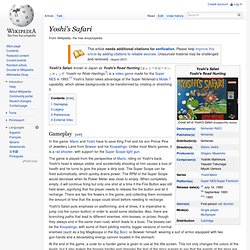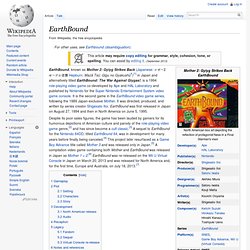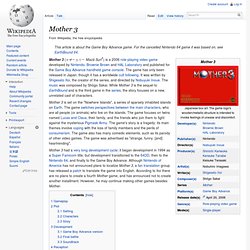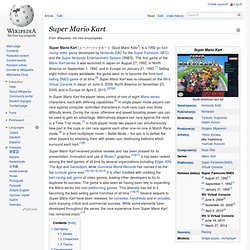

Yoshi's Safari. Yoshi's Safari, known in Japan as Yoshi's Road Hunting (ヨッシーのロードハンティング, Yosshī no Rōdo Hantingu?)

Is a video game made for the Super NES in 1993.[1] Yoshi's Safari takes advantage of the Super Nintendo's Mode 7 capability, which allows backgrounds to be transformed by rotating or stretching it. EarthBound. Despite its poor sales figures, the game has been lauded by gamers for its humorous depictions of American culture and parody of the role-playing video game genre,[2] and has since become a cult classic.[3] A sequel to EarthBound for the Nintendo 64DD, titled EarthBound 64, was in development for many years before finally being canceled.[4] This project later resurfaced as a Game Boy Advance title called Mother 3 and was released only in Japan.[5] A compilation video game containing both Mother and EarthBound was released in Japan as Mother 1 + 2.[6] EarthBound was re-released on the Wii U Virtual Console in Japan on March 20, 2013 and was released for North America and, for the first time, Europe and Australia, on July 18, 2013.[7] Gameplay[edit] EarthBound features many traditional role-playing game elements: the player controls a party of characters who travel through the game's two-dimensional world, which is composed of villages, cities, caves, and dungeons.

Plot[edit] Setting[edit] Mother 3. Gameplay[edit] The gameplay of Mother 3 is very similar to the previous games in the series.

The player controls a main character from an overhead perspective and moves around to explore, talk to characters, and travel through dangerous environments. In dangerous areas, enemies such as Pigmasks, wild animals, and robots will move around and chase the player. If the player comes into contact with an enemy, they will enter battle. Up to three other characters will follow the player, and if any of them are touched from behind, the battle will begin with the player at a disadvantage; this also works in the favor of the players, who can enter a battle with an advantage if the leader touches an enemy from behind. Plot[edit] Setting[edit] Once the Pigmask Army arrives, they begin building many other facilities around the island.
Characters[edit] Story[edit] Soon after, thief-in-training Duster goes with his father Wess to retrieve the mystical Hummingbird Egg from Osohe Castle. Development[edit] F-Zero (video game) Star Fox (video game) Star Fox featured anthropomorphic character designs by Nintendo artist Takaya Imamura, music composed by Hajime Hirasawa and obstacle course style gameplay.

Star Fox was developed by Nintendo EAD with assistance by Argonaut Software, and was published by Nintendo. The game was a critical and commercial success, which established Star Fox as one of Nintendo's flagship franchises. The storyline involves Fox McCloud and the rest of the Star Fox team, who must defend their homeworld of Corneria against the attacking forces of Andross.[1] Fox attacks enemies in the opening Corneria level as Peppy radios in a message. The game's Super FX powered 3D graphics are evident. Star Fox possesses certain unique elements that differentiate it from the standard scrolling shooter. The damage model is another difference. The difficulty in Star Fox is also set in a unique way. In each level, the player is accompanied by three computer-controlled wingmen: Peppy Hare, Slippy Toad, and Falco Lombardi. Super Metroid. Kirby's Dream Land 3. Kirby's Dream Land 3 is the last first party game released for the Super NES in North America, although it is not the final game for the system (the 1998 Super NES version of Frogger would be the final game in North America, while the 2000 Super Famicom remake of Metal Slader Glory was the final game in Japan).

Super Mario World. Super Mario World was an overwhelming critical and commercial success, selling over 20 million copies worldwide, and is considered by many to be one of the best and most innovative Mario games made.

It has been re-released four times, first as part of a combo with Super Mario All-Stars on the SNES in 1994. Super Mario World 2: Yoshi's Island. Super Mario World 2: Yoshi's Island (スーパーマリオ ヨッシーアイランド, Sūpā Mario: Yosshī Airando?

, "Super Mario: Yoshi's Island")[2], commonly referred to as Yoshi's Island, is a platform video game developed and published by Nintendo for the Super Family Computer/SNES console. Despite its North American and European title, this game serves as a prequel to all other games within the established Mario Bros. timeline. While featuring Nintendo's trademark Mario character, the game's graphics and gameplay differed from all previous Mario games in that players control various Yoshi dinosaurs rather than Mario himself, who appears as a helpless infant.
The Legend of Zelda: A Link to the Past. Donkey Kong Country. Donkey Kong Country 2: Diddy's Kong Quest. Donkey Kong Country 2: Diddy's Kong Quest (abbreviated to DKC2) (スーパードンキーコング2 ディクシー&ディディー, Sūpā Donkī Kongu Tsū: Dikushī & Didī?

, Super Donkey Kong 2: Dixie & Diddy) is a 1995 adventure platform game developed for the Super Nintendo Entertainment System (otherwise known as the "SNES") produced by Rareware and published by Nintendo - with Diddy Kong and Dixie Kong starring as the main characters of the game. Donkey Kong Country 2 was first released on November 20, 1995 in North America. Donkey Kong Country 2 is a sequel to the original Donkey Kong Country (1994) which was later followed by Donkey Kong Country 3: Dixie Kong's Double Trouble!
(1996). Donkey Kong Country 3: Dixie Kong's Double Trouble! Donkey Kong Country 3: Dixie Kong's Double Trouble!

Is a platform game developed by Rare and published by Nintendo and was the final installment in the Donkey Kong Country series until Nintendo announced Retro Studios would be reviving the series and developing the next installment, Donkey Kong Country Returns, for the Wii. It was released in late 1996 for the Super Nintendo Entertainment System. The game was ported to Game Boy Advance in 2005 with a different soundtrack. The title was released on the Wii's Virtual Console service in North America on December 24, 2007, and the following day in Europe as a special Christmas update (no longer available as of November 25, 2012).
Super Mario Kart. Super Mario Kart (スーパーマリオカート, Sūpā Mario Kāto?)

Is a 1992 go-kart racing video game developed by Nintendo EAD for the Super Famicom (SFC) and the Super Nintendo Entertainment System (SNES). The first game of the Mario Kart series, it was launched in Japan on August 27, 1992, in North America on September 1, 1992, and in Europe on January 21, 1993.[1] Selling eight million copies worldwide, the game went on to become the third best selling SNES game of all time.[5] Super Mario Kart was re-released on the Wii's Virtual Console in Japan on June 9, 2009, North America on November 23, 2009, and in Europe on April 2, 2010.[2][3][4] Gameplay[edit] Tiles marked with question marks are arrayed on the race tracks; they give special abilities (power-ups) to a player's kart if the vehicle passes over them. Power-ups, such as the ability to throw shells and bananas, allow racers to hit others with the objects, causing them to spin and lose control.
Modes[edit] Single player Mario Kart GP mode.